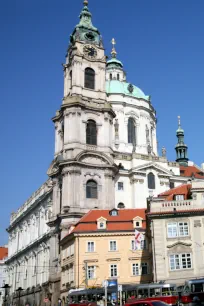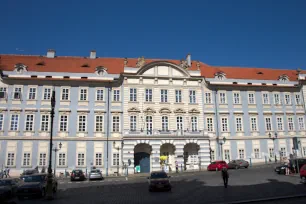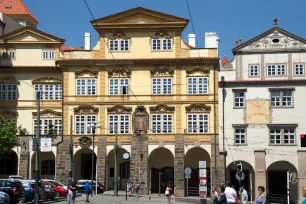Since it was laid out in 1257, Lesser Town Square has been the heart of Lesser Town (Malá Strana), a district situated at the foot of the Prague Castle. The square is dominated by the St. Nicholas Church, an impressive Baroque church that occupies the center of the square.

Magnificent houses with Renaissance and Baroque facades border Lesser Town Square on all sides. During the Middle Ages, when the square was the site of a market for the Prague Castle, the buildings had Gothic designs.
A fire that broke out at the square destroyed most of the houses, and they were rebuilt in Renaissance and later Baroque style. The latter style now dominates, since only a few of the original Renaissance facades kept their original appearance, including the U Mecenaše House (House at the Maecenas) and the Town Hall of Lesser Town.


St. Nicholas Church
In 1673 the Jesuits built a college at the center of the square. Twelve houses, a school and a thirteenth-century church had to make way for the new building, which divides the square in two. Adjacent to the college, the Jesuits built one of Prague’s most impressive ecclesiastic buildings: the eighteenth-century St. Nicholas Church. The church was built at the site of the older, Gothic, church. Kilian Ignaz Dientzenhofer, who had built a namesake church at the Old Town Square, designed an ornately Baroque masterpiece crowned with a seventy meter (230 ft) high dome.
Holy Trinity Column
The lower part of the square was once the site of a pillory and gallows. There are no traces any more of those grim symbols of the Middle Ages, but the upper part of the square has a monument that celebrates the end of a disease that plagued the city throughout the Middle Ages: the bubonic plague. After a late outbreak of the disease was finally under control, the city decided to erect the Plague Column to celebrate the end of the plague.




The column, which is also known as the Holy Trinity Column, was designed by Giovanni Batista Alliprandi. Built in 1715, the monument consists of a small fountain surrounded by putti. A large pedestal supports a soaring obelisk, which reaches a height of about twenty meters (66ft). The pedestal is decorated with statues created by Johann O. Mayer and Ferdinand Geiger. They depict patron saints, including St. Wenceslas and St. John Nepomuk.
Notable Buildings
The largest building at Lesser Town Square is the Liechtenstein Palace (Lichtenštejnský palác), which occupies the west side of the square. It was built in 1621 for Charles of Liechtenstein by reconstructing five existing houses. Liechtenstein amassed much of his fortune by confiscating properties of protestants after they were defeated at the Battle of the White Mountain in 1620.
The largest palace on the north side of the square is the Smirický Palace. The palace, flanked by small towers, was originally built in Renaissance style at the turn of the seventeenth century. In 1763, it was renovated in a late Baroque style. In 1618, this was the site of the second defenestration of Prague – when protestants threw Catholics out of a window – which led to the Battle of the White Mountain.
Adjacent to the Smirický Palace stands the Šternberský Palác (Sternberg Palace) – not to be confused with the larger Sternberg Palace at Castle Square. The left, receding part of the building was originally known as the Bašta (Bastion). This was the site where, in 1541, a devastating fire started that destroyed most of Lesser Town and a large part of Castle District.
After the fire, the house was rebuilt in a Renaissance style. Giovanni Battista Alliprandi later integrated the house in the Baroque Sternberg Palace.
Nearby the Sternberg Palace, along the east side, is the former Town Hall of Lesser Town, built in the early seventeenth century in a High-Renaissance style and crowned with several decorative onion domes.

